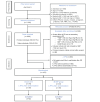The Effect of an mHealth Self-Monitoring Intervention (MI-BP) on Blood Pressure Among Black Individuals With Uncontrolled Hypertension: Randomized Controlled Trial
- PMID: 38941601
- PMCID: PMC11245662
- DOI: 10.2196/57863
The Effect of an mHealth Self-Monitoring Intervention (MI-BP) on Blood Pressure Among Black Individuals With Uncontrolled Hypertension: Randomized Controlled Trial
Erratum in
-
Correction: The Effect of an mHealth Self-Monitoring Intervention (MI-BP) on Blood Pressure Among Black Individuals With Uncontrolled Hypertension: Randomized Controlled Trial.JMIR Mhealth Uhealth. 2024 Aug 6;12:e64632. doi: 10.2196/64632. JMIR Mhealth Uhealth. 2024. PMID: 39106478 Free PMC article.
Abstract
Background: Hypertension is one of the most important cardiovascular disease risk factors and affects >100 million American adults. Hypertension-related health inequities are abundant in Black communities as Black individuals are more likely to use the emergency department (ED) for chronic disease-related ambulatory care, which is strongly linked to lower blood pressure (BP) control, diminished awareness of hypertension, and adverse cardiovascular events. To reduce hypertension-related health disparities, we developed MI-BP, a culturally tailored multibehavior mobile health intervention that targeted behaviors of BP self-monitoring, physical activity, sodium intake, and medication adherence in Black individuals with uncontrolled hypertension recruited from ED and community-based settings.
Objective: We sought to determine the effect of MI-BP on BP as well as secondary outcomes of physical activity, sodium intake, medication adherence, and BP control compared to enhanced usual care control at 1-year follow-up.
Methods: We conducted a 1-year, 2-group randomized controlled trial of the MI-BP intervention compared to an enhanced usual care control group where participants aged 25 to 70 years received a BP cuff and hypertension-related educational materials. Participants were recruited from EDs and other community-based settings in Detroit, Michigan, where they were screened for initial eligibility and enrolled. Baseline data collection and randomization occurred approximately 2 and 4 weeks after enrollment to ensure that participants had uncontrolled hypertension and were willing to take part. Data collection visits occurred at 13, 26, 39, and 52 weeks. Outcomes of interest included BP (primary outcome) and physical activity, sodium intake, medication adherence, and BP control (secondary outcomes).
Results: We obtained consent from and enrolled 869 participants in this study yet ultimately randomized 162 (18.6%) participants. At 1 year, compared to the baseline, both groups showed significant decreases in systolic BP (MI-BP group: 22.5 mm Hg decrease in average systolic BP and P<.001; control group: 24.1 mm Hg decrease and P<.001) adjusted for age and sex, with no significant differences between the groups (time-by-arm interaction: P=.99). Similar patterns where improvements were noted in both groups yet no differences were found between the groups were observed for diastolic BP, physical activity, sodium intake, medication adherence, and BP control. Large dropout rates were observed in both groups (approximately 60%).
Conclusions: Overall, participants randomized to both the enhanced usual care control and MI-BP conditions experienced significant improvements in BP and other outcomes; however, differences between groups were not detected, speaking to the general benefit of proactive outreach and engagement focused on cardiometabolic risk reduction in urban-dwelling, low-socioeconomic-status Black populations. High dropout rates were found and are likely to be expected when working with similar populations. Future work is needed to better understand engagement with mobile health interventions, particularly in this population.
Trial registration: ClinicalTrials.gov NCT02955537; https://clinicaltrials.gov/study/NCT02955537.
International registered report identifier (irrid): RR2-10.2196/12601.
Keywords: blood pressure; hypertension; mHealth; mobile health; mobile phone; smartphone.
©Lorraine R Buis, Junhan Kim, Ananda Sen, Dongru Chen, Katee Dawood, Reema Kadri, Rachelle Muladore, Melissa Plegue, Caroline R Richardson, Zora Djuric, Candace McNaughton, David Hutton, Lionel P Robert, Sun Young Park, Phillip Levy. Originally published in JMIR mHealth and uHealth (https://mhealth.jmir.org), 28.06.2024.
Conflict of interest statement
Conflicts of Interest: LRB is an Editor in Chief for JMIR mHealth and uHealth.
Figures



References
-
- Tsao CW, Aday AW, Almarzooq ZI, Alonso A, Beaton AZ, Bittencourt MS, Boehme AK, Buxton AE, Carson AP, Commodore-Mensah Y, Elkind MS, Evenson KR, Eze-Nliam C, Ferguson JF, Generoso G, Ho JE, Kalani R, Khan SS, Kissela BM, Knutson KL, Levine DA, Lewis TT, Liu J, Loop MS, Ma J, Mussolino ME, Navaneethan SD, Perak AM, Poudel R, Rezk-Hanna M, Roth GA, Schroeder EB, Shah SH, Thacker EL, VanWagner LB, Virani SS, Voecks JH, Wang NY, Yaffe K, Martin SS. Heart Disease and Stroke Statistics-2022 Update: A Report From the American Heart Association. Circulation. 2022 Feb 22;145(8):e153–639. doi: 10.1161/CIR.0000000000001052. https://www.ahajournals.org/doi/abs/10.1161/CIR.0000000000001052?url_ver... - DOI - DOI - PubMed
-
- O'Donnell MJ, Xavier D, Liu L, Zhang H, Chin SL, Rao-Melacini P, Rangarajan S, Islam S, Pais P, McQueen MJ, Mondo C, Damasceno A, Lopez-Jaramillo P, Hankey GJ, Dans AL, Yusoff K, Truelsen T, Diener H, Sacco RL, Ryglewicz D, Czlonkowska A, Weimar C, Wang X, Yusuf S, INTERSTROKE investigators Risk factors for ischaemic and intracerebral haemorrhagic stroke in 22 countries (the INTERSTROKE study): a case-control study. Lancet. 2010 Jul 10;376(9735):112–23. doi: 10.1016/S0140-6736(10)60834-3.S0140-6736(10)60834-3 - DOI - PubMed
-
- Valensi P, Lorgis L, Cottin Y. Prevalence, incidence, predictive factors and prognosis of silent myocardial infarction: a review of the literature. Arch Cardiovasc Dis. 2011 Mar;104(3):178–88. doi: 10.1016/j.acvd.2010.11.013. https://linkinghub.elsevier.com/retrieve/pii/S1875-2136(11)00046-5 S1875-2136(11)00046-5 - DOI - PubMed
Publication types
MeSH terms
Associated data
Grants and funding
LinkOut - more resources
Full Text Sources
Medical
Miscellaneous

